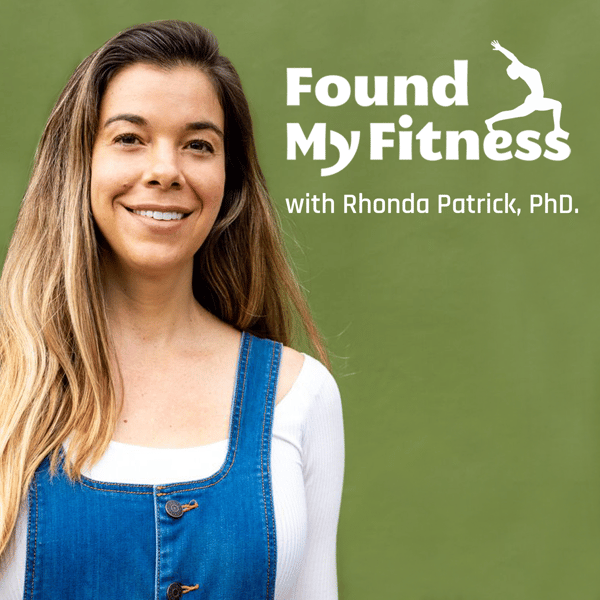#062 Dr. Steve Horvath on epigenetic aging to predict healthspan: the DNA PhenoAge and GrimAge clocks
FoundMyFitness
Rhonda Patrick, Ph.D.
4.8 • 5.5K Ratings
🗓️ 22 December 2020
⏱️ 94 minutes
🧾️ Download transcript
Summary
Steve Horvath
Steve Horvath, PhD, is a professor of human genetics and biostatistics at UCLA's Fielding School of Public Health
Dr. Steve Horvath has analyzed large data sets of DNA methylation profiles to derive an algorithm that accurately predicts a person's chronological age across multiple cells, tissues, and organs, and even mammalian species. He built on this algorithm to develop second-generation clocks that could predict time-to-death among people of the same chronological age, as well as lifespan and healthspan.
In this episode, we discuss:
- 00:00 - Introduction and overview
- 20:24 - Horvath Aging Clocks
- 26:36 - Heredity determines aging
- 35:49 - DNAm PhenoAge vs GrimAge
- 45:58 - Slowing the epigenetic clock
- 01:10:43 - Epigenetics: Cause or consequence of aging?
- 01:16:43 - Vitamin D reverses epigenetic age
- 01:19:07 - Omega-3 slows GrimAge clock
- 01:24:19 - Ongoing research
If you’re interested in learning more, you can read the full show notes here: https://www.foundmyfitness.com/episodes/steve-horvath
Join over 300,000 people and get the latest distilled information on aging straight to your inbox weekly: https://www.foundmyfitness.com/newsletter
Become a FoundMyFitness premium member to get access to exclusive episodes, emails, live Q+A’s with Rhonda and more: https://www.foundmyfitness.com/crowdsponsor
Transcript
Click on a timestamp to play from that location
| 0:00.0 | Hello my friends, it's been a while. This is the last episode of 2020 and while 2020 has been a tough year, this episode is fantastic. |
| 0:10.0 | Today's guest is Dr. Steve Horvath, a professor of genetics and biostatistics at UCLA, and the creator of the Horvath Epigenetic Aging Clock. |
| 0:19.0 | Or should I say clocks, plural as there are more than one. |
| 0:23.0 | The development of ways to measure aging is very important because finding clever ways to quantitative aging is the first step we have to take if we actually hope to find any therapies that can improve human health span. |
| 0:36.0 | That's what makes Dr. Horvath's work so important. His lab has found something truly incredible, a story of our aging, writing a top RDNA as epigenetic marks. |
| 0:47.0 | This measurement may be more fundamental, more interesting than many other markers because as we'll discuss in a moment, it's predictive value. |
| 0:56.0 | In this episode, we're going to talk about two generations of epigenetic clocks. |
| 1:01.0 | The first generation, a chronological age detector. |
| 1:05.0 | Well, the Horvath Aging Clock is what I sometimes call the so-called Pan-Tissue Epigenetic Clock. So it is the most accurate molecular measure of age. It applies to all cells in the bodies. |
| 1:21.0 | So we can take cells from basically any tissue in the body and predict true chronological age from the robust genetic marks that exist on the DNA. |
| 1:30.0 | Interestingly, these marks are surprisingly robust. You can almost think of them as hard mechanical switches that toggle gene expression on or off. |
| 1:38.0 | In fact, Dr. Horvath says the marks on DNA in blood samples exposed to high heat still produce beautiful, clear data. |
| 1:46.0 | I want you to think about that for a moment because it really says something about the usefulness of this investigational tool in terms of reliability. |
| 1:53.0 | That's a rare thing in biology where even the tiniest of factors can throw off an experiment entirely. But not only is this tool reliable, it's versatile. |
| 2:02.0 | In fact, the methylation profile of almost any mammalian cell, at least those with DNA, can be run through some optimized version of Dr. Horvath's algorithm to predict the age of the organism with a surprising degree of accuracy. |
| 2:14.0 | So if somebody provides, for example, DNA from blood or DNA from neurons or DNA extracted from saliva or urine, I can very accurately estimate their age. |
| 2:29.0 | Imagine the implications for forensics. |
| 2:33.0 | What if you have a forensic sample, let's say a blood stain or a room for a couple of weeks or even a bone sample collected a couple of months later, all of these data, in my opinion, would still lead to very good methylation measurements for the purpose of measuring aging. |
| 2:59.0 | When we think of other measures like measures of DNA damage, for example, they're what I've worked with called gamma H2AX. These say such interesting things, but God help you if you let the blood sample sit for two hours at room temperature. |
| 3:13.0 | The ability to determine chronological age is just one of some of the exciting implications of Dr. Horvath's work on epigenetic clocks. |
| 3:20.0 | We have some epigenetic clocks whose purpose is really to measure chronological age period. But then we have other epigenetic clocks that are really defined to be lifespan predictors or they are meant to predict time to death or time to major onset of a disease or what people call health span. How long are you healthy? |
| 3:46.0 | The second generation epigenetic clocks focus on determining health span and even lifespan. |
... |
Please login to see the full transcript.
Disclaimer: The podcast and artwork embedded on this page are from Rhonda Patrick, Ph.D., and are the property of its owner and not affiliated with or endorsed by Tapesearch.
Generated transcripts are the property of Rhonda Patrick, Ph.D. and are distributed freely under the Fair Use doctrine. Transcripts generated by Tapesearch are not guaranteed to be accurate.
Copyright © Tapesearch 2025.

